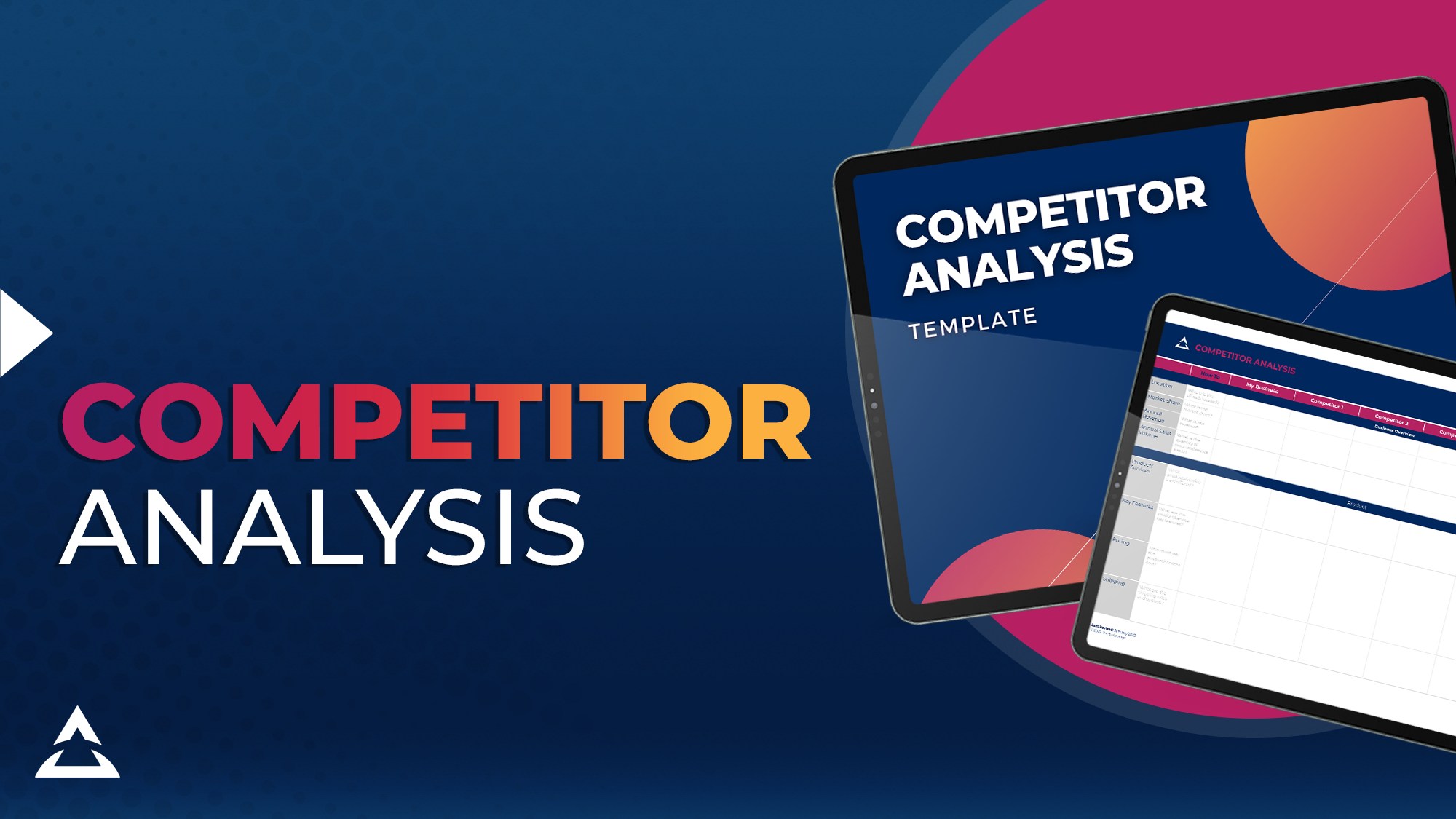
Being a small business owner and going into business for yourself is fantastic, but whatever industry you’re venturing into, someone is likely already there solving the problem you're looking to solve too. This is not a bad thing as it shows there is demand for that product or service. It can also show you how it is done, and how you can do it better.
Understanding everything you need to when starting a business will lead you into many corners, and one of those corners is conducting a competitor analysis. It is good to know what your competitors are doing so you can find a niche and own it, so that you don’t copy your competitors and run into bad press, or waste a lot of money on marketing going to the wrong target audience.
We will give you eight easy steps on how to conduct a competitor analysis so you can find your place in the market, and potentially steal some customers from them, to you.
Download your free copy of our competitor analysis today.
What is a competitor analysis?
A competitor analysis is where you strategically compare aspects of your direct and indirect competitors in the market. They help you create better marketing strategies, understand price points and other key information. You can adjust your marketing and your target audience, and discover niches that are yet untapped, all to help your business compete against other companies.
What are the benefits of a competitor analysis?
While conducting a competitor analysis can be time-consuming, the advantages and benefits to you and your business are many.
- Develop your Unique Selling Proposition - You need to differentiate yourself from your competition, so you stand out and are distinctive. By knowing the voice and branding, and target audience of your competition, you can find the niche to be unique.
- Establish benchmarks - You can see what it takes to be successful by how well your competitors are doing. This becomes the standard you need to achieve to be successful.
- Fine-tune your products and services - If you discover that a competitor has already gone to market with something you’re offering, you have a chance to alter your products or market them differently to a different audience.
- Identify potential roadblocks and threats - By looking at the market, you can forecast roadblocks you may encounter. Just look at the supply chain stress which resulted from COVID-19. If your competitors have found a workaround for this, you can use this same strategy at the start and make it part of your business as usual.
So why do it?
If you’re serious about going into business for yourself, you need as much intel on the market and who the players are. Going into the market ignorant can set yourself up to fail.
Writing a business plan
One of the big ticket items is a business plan. If you're scouting for investors, you need to have a business plan to indicate that you know where you’re going and how you will get there. Part of that business plan should include a competitor analysis to show potential investors who you’re up against and how you plan to beat them.
Creating a new product
As we know, there is nothing new out there in the market. However, you can improve on something in the market, or offer better value. You need to see what the others are doing to find that USP, to find your niche.
Get benchmarks to measure your growth
How do you know if you’re succeeding? By comparing yourself against the competition. It can be in the number of social media followers, the number of outlets selling your products, or pure dollar figure turnover. If you know the figures that your competitors are pulling, then you have a standard to reach to consider yourself a winner.
Develop your Unique Selling Point
You want to be different to your competitors, and have your voice stand out from the crowd. Even McDonald's and Hungry Jack's sound different in their advertising and marketing. By understanding the tone of voice and target audience of your competitors, you can position your products and services differently and appeal to different people.
How to do a competitor analysis: step by step
You know why you need one and how important they are, so how do you conduct a competitor analysis? Here are eight steps you need to take to complete a competitor analysis.
1. Find out who your competitors are
The very first step is to know who you’re up against. If you are starting a boutique clothing shop, you won’t compare yourself against H&M or other big retailers.
Break down your competitors into two lists - direct and indirect.
- Direct - These competitors offer a product or service which is very similar to yours. They could even operate in the same geographical location as you - think cafes or restaurants.
- Indirect - These businesses offer a product or service which is not directly similar to yours, but could be easily substituted in a pinch. Chain store fast food, versus the local fish & chip shop.
2. Do a SWOT analysis
A SWOT analysis examines a business's Strengths, Weaknesses, Opportunities and Threats. To learn more, in detail, about how to conduct a SWOT analysis, read our article.
By conducting a SWOT, you can find vulnerabilities and gaps in the market you can take advantage of, see where your competitors are doing well, and choose not to waste resources trying to compete there.
You can find where your competitor has an advantage, and analyse how they have it. Is it budget? Is it local knowledge? Can you realistically compete against it? On the flip side, you can also see where your brand has an advantage. It could be cheaper costs or more functions.
Are there opportunities in the market that you can take advantage of? Are there potential threats that your competitor poses to your success? Do they have exclusive rights with a supplier?
A good SWOT will give you a broad view of the marketing battleground. It will give you insight into where to intelligently invest money to get the best return on investment.
3. Look at their customer journey
Customer journeys are so important in today’s switched-on consumer landscape. It is easy to click on another business if you struggle with your journey. If you can analyse the customer journeys of those businesses who do it well, you can unlock the secret sauce for retaining loyal customers.
Don’t be afraid to be a mystery shopper and try out various customer journeys with your competitors. Note every step taken before and after the shopping cart.
Things to look out for in a customer journey analysis:
- How easy is it to find a specific product?
- What is the search function like?
- Are categories clearly labelled?
- If something is not in stock, is that clearly labelled too?
- How easy is it to add to your cart and buy?
- What questions do they ask you during the process
- Is it too invasive?
- Are there any after-sales services?
- Did you enjoy it?
Get a copy of our free customer journey template today.
4. What is their brand positioning?
Brand positioning is where you own that space in the market. It is your niche and your unique selling point. Are you positioned as a family brand? Are you a budget brand or a high class brand? Are you for the everyday people or exclusive and luxury?
Knowing where your brand is positioned versus your competitors will give you an insight into the target audience. It will allow you to work on your tone of voice, and find a pricing point and a sales process to attract your ideal customer.
To figure out brand positioning, ask some questions-
- Who are you targeting with your products and services?
- What need are you serving?
- Why should your audience believe you over your competition?
Once you have answered these questions, you need to communicate your position to your team (internally), so they are on the same page, and externally (audience), so you begin collecting customers.
5. Check out their pricing
There is a marketing belief that you shouldn’t compete on pricing. People who are loyal to brands will justify the cost, no matter what the price. However, it is good to know the price points of your competition. There will be people choosing to save money on a similar product.
The price of an item can be determined by the costs in manufacturing, which can be supply and time costs, plus a percentage on top for profit. If you can get cheaper supplies, or make a product quicker, hence less time, you can offer a more affordable product to market.
If, during this discovery process, you noticed a competitor’s products or services are consistently lower than yours, investigate further. Do they have deals with specific suppliers? Are the materials used in the process better or lower quality? Are they making a bigger profit on another product and keeping the items you’re competing against as a loss-leader.
6. What technology are they using?
The technology used can be in the production method or the software behind the scenes. Do they have a powerful CMS with big customer insights driving economical marketing campaigns?
Do they have the latest tech, while you’re running on something four or five years old? Can you upgrade to match them?
One way to find out what tech a company uses is to check their job ads. It will list what an applicant must be competent in or understand. This would list applications and software packages, giving you an idea of what they’re running under the hood.
7. Look at their products or service
Look directly at what you are bringing to the market and what your competitors already have. How do they look, side-by-side? Can you tell the target audience just by looking? Does one look ‘better’ than the other?
Make a list of the features for each product you directly compete against. From this list, can you exploit any differences? How do you feel the pricing matches with the features?
8. What's their digital presence like?
Look at your competitor’s online presence and compare it to yours.
- Website - Is it easy to use and engaging?
- Content - Do they have blogs? When was the last one written? Do they read well?
- Social media - How many platforms are they on, and are they active? Do they have a lot of followers?
- What kind of content? - Do they produce videos? What about instructional blogs and whitepapers?
- Do they have social media advertising? - Is it enticing? Does it lead you to a landing page to buy?
You can use tools such as Semrush to analyse a competitor’s social media marketing campaign and other insightful pieces of data.
Need help with a competitor analysis?
Do you want some help discovering your competitors and conducting a competitor analysis? Download our free competitor analysis today and let us help set you on the path of understanding your market and the players better, and kickstart your journey to building a successful strategy.
Related Posts
Join the movement.
Your Entourage journey starts here. Join Australia's largest community of over 500,000 business owners and entrepreneurs, and receive instant access to exclusive content and updates delivered straight to your inbox.





